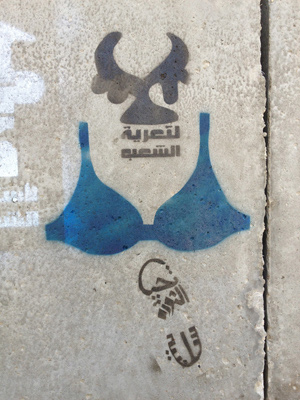Blue Bra Graffiti (Bahia Shehab)
BY Nama Khalil
2 September 2014, Design and Violence
From the curators: Using sexual violence to intimidate, crack down on dissent, or brutalize opposition is nothing new. Neither is graffiti—illicit drawings are older than Pompeii. However, such designs have taken on new life of late, paralleling an increased public and political focus on female sexuality. During the wave of disparate yet interconnected protests that made up the Arab Spring (2010–ongoing), graffiti emerged as an untamable form of grassroots resistance to such violence. The graffiti art sprayed in the streets of Cairo during and after the revolution of 2011 attempted to raise awareness about injustices—from the personal and gender-based to the economic and political—in Egypt, giving a voice to the oppressed. Professor Bahia Shehab’s tag, a bright-blue bra, refers to the image of a young woman who was publicly dragged and beaten by members of the Egyptian military in Tahrir Square in December 2011. During the attack, the woman was half-divested of her abaya, exposing her body and blue underwear. Images of this attack rapidly became a symbol of the rampant abuse of power by Egyptian officials. As Shehab explained in 2012, her stenciled blue bra means no: “No to stripping the people…. The blue bra is to remind us of our shame as a nation when we allow a veiled woman to be stripped and beaten on the street.” Shehab’s blue bra graffiti has since been covered and no longer exists on the streets of Cairo.
The blue bra is not the first thing that I see. The big, black, bold letters spelling la (no) and the text that reads, “No to the stripping of people” catches my attention first. I then notice the bra, a private object made public, and an outline of a foot that states, “Long live the revolution.” In its entirety, I see an outline of a woman’s body that forces me to pause, reflect, and remember how a young woman, donning the abaya, was stripped, dragged, and beaten by Egyptian policemen.
As a sign, the blue bra references the photograph of the actual beating that took place on December 16, 2011; the realness of the image provides it with authority to act as witness to the occurrence it captured. The image recorded an incident in which blatant, state-sanctioned violence was used to physically coerce and terrorize protesters. The beating that ensued is not novel—the Egyptian police are notorious for their forceful handling of citizens—but the act of beating an ordinary female citizen in public reifies the possibility of it happening to anyone. Through the photographic record a traumatic testimony is provided that moves beyond an individual experience to a collective body. It moves from “personal trauma to public memory and provides a sense of shared vulnerability” (Extremities: Trauma, Testimony, and Community. Ed., Miller and Tougaw). Given the nomenclature of Set el Banat, honorable lady, she was instantaneously elevated and highly regarded. She was not viewed as a victim, nor was she seen as weak and vulnerable. She was not objectified or ever referred to by her blue bra. She represented the struggle for life, freedom, and social justice. She spoke for an entire nation and prompted its citizens to respond. She symbolized the Egyptian revolution.
Enraged by this public act of violence, the blue bra makes me think about the social suffering of a nation, as this female protester does not stand alone—she is placed next to other demands, other people, and other societal problems that were highlighted through a litany of Nos stenciled on walls throughout Cairo: “No to military rule,” “No to a new pharaoh,” “No to violence,” “No to blinding heroes,” “No to barrier walls,” and “No to the stripping of people.” Each and every declaration is made in response to a real-life incident.
Each stencil, mural, photograph, avatar, poster, political cartoon, and song is designed to make demands, educate, mock, ridicule, and comment on the country’s political turmoil. With every new incident, a new type of visual response is made. The ongoing visual critiques harnessed in Egypt show an immense wave of creativity that is sharp and witty. Most images cannot be recycled because each has its own contextual backstory. Graffiti is meant to be fast, transitional, and interactive; the use of graffiti designs picked up momentum in Egypt because they allowed for quick messages to be sprayed and then circulated online. With the political situation in Egypt succumbing to a military coup in 2013—as I write this, a former military general, Abdel Fattah Al Sisi, is Egypt’s president—Shehab’s A Thousand Times No stencils are as timely and relevant as when the artwork was made, almost three years ago. These stencils elicit more emotional response than any work so far made, or that could be made. Although they were sprayed and then erased, the demands they make are still viable, and the state-sanctioned violence that they highlight is still a recurring problem. Once again, people are chanting “no to military rule,” and “no to violence.”
http://designandviolence.moma.org/blue-bra-graffiti-bahia-shehab/
